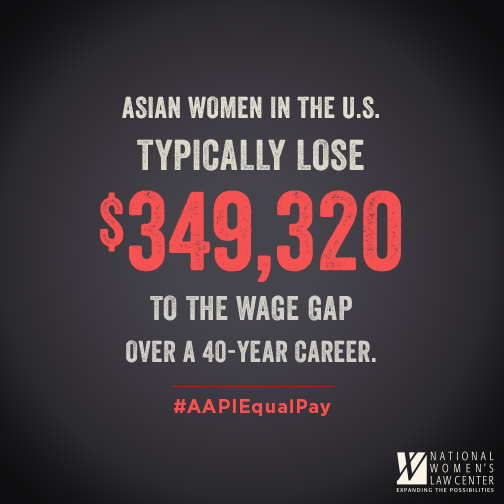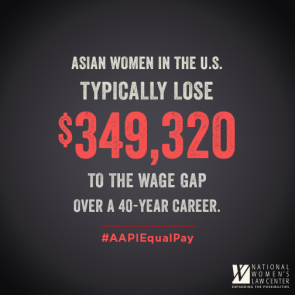Abortion rights, women of color, and LGBTQIA+ people are under attack. Pledge to join us in fighting for gender justice.
Minding the Gap on Asian Women’s Equal Pay Day

 We’re more than two months into 2017, but women are still feeling the effects of discrimination from 2016. Today, we observe Asian women’s equal pay day, which represents how many extra days an Asian woman in the U.S. typically has to work into this year to earn what a white, non-Hispanic man earned last year.
We’re more than two months into 2017, but women are still feeling the effects of discrimination from 2016. Today, we observe Asian women’s equal pay day, which represents how many extra days an Asian woman in the U.S. typically has to work into this year to earn what a white, non-Hispanic man earned last year.
Asian women in the U.S. working full time, year round typically are paid only 85 cents for every dollar paid to white, non-Hispanic men. This 15 cent wage gap is five cents smaller than the 20 cent wage gap for women of all races compared to men of all races. And Asian women’s wage gap is smaller than the wage gaps experienced by African American women, who make 63 cents for every dollar made by white non-Hispanic men; Native American women who make 58 cents; and Latinas who make 54 cents.
These numbers make it seem like Asian women are making better economic progress than other women in the U.S., but it’s complicated. Looking at the wage gap for “Asian women” collectively masks substantial disparities between several racial and/or ethnic subgroups of women. The Asian community in the U.S. is incredibly diverse, with many different racial and/or ethnic groups and languages, and varying educational, employment, and immigration histories and opportunities.
This diversity and complexity is reflected in different wage gaps both among different subgroups of Asian women, as well between men and women within a particular subgroup. For example, Burmese and Fijian women make less than half of what white, non-Hispanic men make, while a few subgroups, such as Indian and Taiwanese women, make more than white, non-Hispanic men. But when compared to Asian men of the same subgroup, Asian women experience a gender wage gap. For instance, Indian women make just 76 cents for every dollar made by Indian men, and Taiwanese women make only 80 cents for every dollar made by Taiwanese men.
The wage gap has serious economic consequences for Asian women. Like other women of color, Asian women experience a wage gap across occupations and education levels. And the wage gap increases with age, leaving older Asian women vulnerable to poverty as they reach retirement. An Asian woman typically loses $349,320 over the course of a 40-year career due to the wage gap. But in ten states, Asian women lose more than half a million dollars over a 40-year career compared to white men. If you’re an Asian woman living in California, you stand to lose $779,880; if you’re an Asian woman living in Alaska, you stand to lose more than $1 million.
| Ten Worst States for Asian Women’s Lifetime Losses Due to Wage Gap | |||||
| Rank | State | Asian women’s earnings | White, non-Hispanic Male Earnings | Lifetime Losses Due to Wage Gap | How Many Years an Asian Woman Must Work to Catch up to What a non-Hispanic White Man Makes in 40 Years |
| United States | $48,471 | $57,204 | $349,320 | 47.2 | |
| 10 | Rhode Island | $40,336 | $56,468 | $645,280 | 56.0 |
| 9 | Nevada | $37,169 | $53,760 | $663,640 | 57.9 |
| 8 | Utah | $37,021 | $53,846 | $673,000 | 58.2 |
| 7 | Oklahoma | $31,026 | $48,166 | $685,600 | 62.1 |
| 6 | Colorado | $40,287 | $57,895 | $704,320 | 57.5 |
| 5 | California | $51,308 | $70,805 | $779,880 | 55.2 |
| 4 | Vermont | $27,474 | $47,070 | $783,840 | 68.5 |
| 3 | Louisiana | $32,163 | $55,386 | $928,920 | 68.9 |
| 2 | District of Columbia | $69,415 | $92,679 | $930,560 | 53.4 |
| 1 | Alaska | $33,039 | $63,779 | $1,229,600 | 77.2 |
| State wage gaps calculated by National Women’s Law Center (NWLC) are based on 2011-2015 American Community Survey Five-Year Estimates (http://www.census.gov/acs/www/). National wage gap calculated by NWLC is based on 2016 Current Population Survey, Annual Social and Economic Supplement (http://www.census.gov/hhes/www/income/). All earnings are in 2015 dollars. Figures are based on women’s and men’s median earnings for full time, year round workers. “Lifetime losses due to wage gap” is what Asian women would lose, based on today’s wage gap, over a 40-year career, compared to white, non-Hispanic men. Figures are not adjusted for inflation. Earnings are in 2015 dollars. Ranks based on unrounded data. | |||||
All Asian women in the U.S. deserve equal pay, no matter where they live. You can make a difference by joining us today for a Twitter storm at 2 pm ET to raise our voices and demand action to achieve #AAPIEqualPay.




